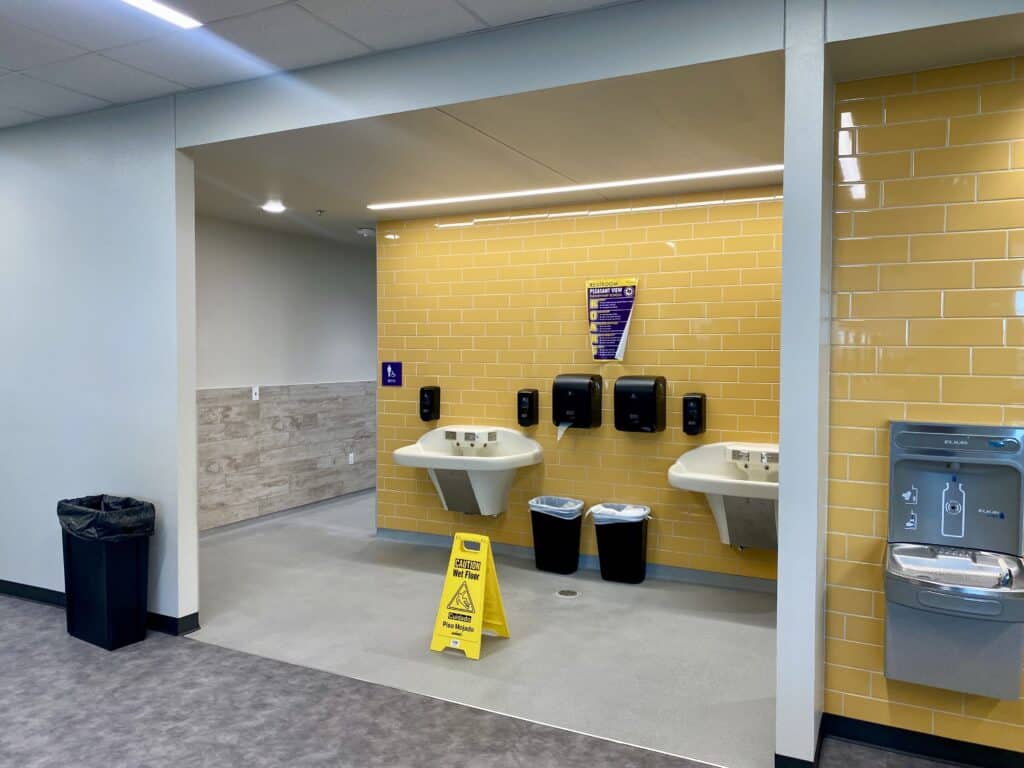Crime Prevention Through Environmental Design (CPTED) is a multidisciplinary approach that aims to deter criminal behavior by improving the design of the built environment.
By reducing disputes, and violence, and promoting positive behavior, schools can enhance safety and security for both students and staff.
This involves applying various CPTED principles, such as natural surveillance, access management, territoriality, and maintenance, that have been shown to effectively decrease incidents of crime in school environments.
One specific area of focus for school safety is the design of maze-like bathrooms, which have been gaining attention lately for their potential to improve safety standards.
These bathrooms allow for less supervision, reducing the chances of conflicts and misconduct while still maintaining students’ privacy.
By incorporating CPTED principles into the design of maze bathrooms, schools can create an environment that not only promotes responsible behavior but also provides a safe and secure space for students to use the facilities.
Implementing such designs can contribute to achieving the overarching goal of fostering secure and positive learning environments.
Foundations of CPTED in School Environments
Understanding CPTED
Crime Prevention Through Environmental Design (CPTED) is a method that aims to enhance the layout of physical spaces to lower the chances of conflicts and violence, while encouraging good behavior.
In the context of schools, CPTED has been used to assess and improve various aspects of the physical environment that could potentially contribute to an increase in violence-related behaviors and perceptions of students.
Historical Development
CPTED has its roots in the field of environmental criminology, which emerged in the early 20th century. The approach seeks to analyze the relationship between criminal behavior, victims, and the environment.
Over the years, CPTED has evolved and been successfully applied in various settings, including schools, residential areas, and businesses.
Reports of decreased gun violence, youth homicide, disorderly conduct, and violent crime have been documented in communities that have implemented CPTED activities in their schools.
Core CPTED Strategies
CPTED strategies can be summarized into four primary principles:
Natural Surveillance
This focuses on creating an environment where potential offenders are visible and can be monitored easily. It entails designing open spaces, ensuring proper lighting, and using security cameras when needed.
Access Control
This principle is about controlling who has access to a particular area by designing effective barriers and employing tools such as locked doors, gates, and signage.
Territoriality
By encouraging feelings of belonging and pride among students and staff in their school, territorial reinforcement helps create a safer and more secure environment.
This can be achieved through clear borders and boundaries, the use of school colors and logos, and well-maintained landscapes.
Maintenance
Proper upkeep of the school environment plays a significant role in crime prevention. Clean and well-maintained facilities send a message that there is an active and vigilant presence, deterring potential criminals.
In the context of school restrooms, maze-style entrances can represent an effective application of CPTED principles.
This approach would discourage unsupervised loitering and illicit activities and promote a sense of accountable use of space.
Designing Secure and Functional School Restrooms
Maze Bathroom Concept
The maze bathroom concept is an innovative approach to designing school restrooms, which focuses on enhancing safety, comfort, and functionality.
This design eliminates traditional doors, creating a winding entrance that provides privacy without compromising visibility and access for security professionals.
This approach facilitates ease of monitoring and improves the overall physical environment of restrooms.
Architectural Design Considerations
When designing maze bathrooms, architects should prioritize visibility, natural lighting, and access management.
Using materials like high partitions and frosted glass can maximize privacy while allowing natural light to penetrate the space.
Implementing efficient lighting systems helps in maintaining an inviting atmosphere and provides proper illumination for security monitoring.
Incorporating user-friendly fixtures such as hands-free faucets, easy-to-reach toilets, and unobstructed pathways can contribute to the restroom’s functionality.
Additionally, architects should be mindful of aesthetics, using calm colors and clean lines to create an appealing and comfortable physical environment.
Safety and Accessibility Features
Safety features should be a top consideration in the maze bathroom design, addressing concerns of students and security professionals alike.
A well-designed maze entrance should offer increased visibility, allowing adults to detect if a child is in distress without compromising privacy.
Accessible restrooms are vital for the school environment. These should include space for wheelchairs, grab bars, and integrated alarm systems for those in need of assistance.
Adequate lighting, both natural and artificial, helps create a safe and comfortable environment, while optimal door configurations contribute to browsing/notification protection during both school hours and recreational periods.
In essence, combining the maze bathroom concept with architectural design considerations and safety features results in secure, functional, and user-friendly school restrooms that cater to the diverse needs of students and staff.
Implementation and Assessment of CPTED in Schools
CPTED School Assessment (CSA) Procedures
The CPTED School Assessment (CSA) is a method employed to evaluate the implementation of CPTED principles within three main areas: school grounds, school buildings, and school interiors.
CSA covers several aspects such as natural surveillance, access management, territoriality, and physical maintenance.
A detailed assessment of these factors can contribute significantly to crime prevention in educational institutions.
Some key elements to be considered during the assessment are:
- Ensuring adequate visibility and natural lighting in corridors, classrooms, and common areas.
- Securing entry and exit points, and managing access control.
- Establishing clear boundaries to distinguish public, semi-public, and private spaces.
- Encouraging students and staff to feel like they are a part of and actively involved in their school community.
Community Involvement and Education
Apart from focusing on the design of the built environment, CPTED also emphasizes on the importance of community involvement and education.
Using environmental design to prevent school violence has shown that communities applying CPTED activities have reported decreases in gun violence, youth homicide, disorderly conduct, and violent crime.
By involving local communities, law enforcement, and school stakeholders, the CPTED approach can develop a more cohesive strategy for crime prevention.
Key components of community involvement include:
- Establishing partnerships among school administrators, teachers, parents, students, and community members.
- Conducting workshops and seminars to create awareness about CPTED principles and practices.
- Collaborating with law enforcement agencies to ensure effectiveness and vigilance.
Maintenance and Sustainability
Long-term success of CPTED initiatives in schools requires continuous attention to maintenance and sustainability.
Physical maintenance not only prolongs the effectiveness of implemented measures but also demonstrates a commitment to providing a safe and orderly environment for students, staff, and visitors.
Essential aspects of maintenance and sustainability are:
- Regularly inspecting and repairing any damaged or deteriorating structures.
- Ensuring cleanliness and orderly arrangement within school premises.
- Making necessary adjustments as per the changing needs and requirements of the school environment.
By integrating the CPTED assessment, community involvement, and maintenance, a school can effectively implement and sustain crime prevention efforts that contribute to a safer and more conducive learning environment.
Outcomes and Case Studies
Reducing Crime and Vandalism
The use of Crime Prevention Through Environmental Design (CPTED) strategies, such as maze bathrooms, has proven effective in reducing crime and vandalism at schools.
In a study of 50 middle schools, significant associations were found between physical attributes of schools and violence-related behaviors among students.
Maze bathrooms, by design, minimize opportunities for undesirable incidents to occur, thus contributing to school safety.
Additionally, CPTED’s impact goes beyond just addressing crime and vandalism. For example, communities applying CPTED activities reported decreases in gun violence.
These successful outcomes show that adopting well-designed environments can make a significant difference in ensuring a safer atmosphere for students.
Enhancing Student Experience
Besides crime prevention, incorporating maze bathrooms in schools also results in benefits like improved social interaction and reduced fear among students.
By removing the need for doors, these bathrooms promote a sense of openness that encourages positive interactions among students.
Furthermore, the open design helps alleviate any potential fear of entering enclosed spaces, making students feel more at ease while using the facilities.
School Districts’ Best Practices
Several school districts have embraced CPTED principles to support a safer learning environment. Some of the best practices include:
- Clear signage: Clear and strategically placed signs direct students towards the maze bathrooms and other key areas, reducing confusion and promoting orderliness.
- Maintenance: Regular cleaning and upkeep of the facilities contribute to a positive environment that discourages vandalism and other undesirable behaviors.
- Collaboration: Engaging local law enforcement, parents, and the community in discussions about CPTED implementation can provide valuable insights and foster support for the initiative.
By adopting these best practices, schools can ensure that the benefits of maze bathrooms and other CPTED-based initiatives are sustained and continually improved upon.
Frequently Asked Questions
What principles of CPTED are applicable to the design of school bathrooms?
The main principles of Crime Prevention Through Environmental Design (CPTED) applicable to school bathroom design include natural surveillance, access control, territorial reinforcement, and maintenance.
Implementing these principles can help create a safer environment in school restrooms, deterring potential criminal and harmful activities.
How does maze bathroom design in schools contribute to student safety according to CPTED?
A maze bathroom design contributes to student safety by eliminating doors, which increases natural surveillance.
This layout allows staff and students to easily monitor restroom entrances and exits while still maintaining privacy.
Without doors, it becomes more challenging for unauthorized individuals or criminal activities to go unnoticed.
What are effective CPTED strategies for maintaining a secure environment in school restrooms?
Effective CPTED strategies for school restrooms include installing adequate lighting, providing clear lines of sight, and removing hidden corners.
Additionally, access control measures, such as limiting access to restrooms during non-peak hours and using identification badges, can help maintain a secure environment.
How does territorial reinforcement manifest in the context of school bathroom layouts?
Territorial reinforcement in school bathrooms can manifest through clear signage, using contrasting colors on walls and floors, and strategically positioning mirrors.
These measures help define boundaries and make it evident that the area is being monitored, which can reduce the risk of violence and crime in restroom facilities.
What CPTED measures can enhance access control in educational institutions, specifically in restroom areas?
To enhance access control in school restrooms, educational institutions can implement measures like requiring key card access or staff supervision during certain hours, limiting restroom entrances and exits to specific areas, and using CPTED School Assessments to evaluate and improve restroom security.
In what ways can consistent CPTED maintenance improve the security of bathroom facilities in schools?
Consistent CPTED maintenance in school restrooms improves safety by ensuring that lighting is functional, surveillance equipment is operational, and graffiti or vandalism is promptly addressed.
Regular maintenance helps maintain a clean and orderly environment, thereby reinforcing the message that school restrooms are monitored and promoting a sense of safety in the educational institution.








